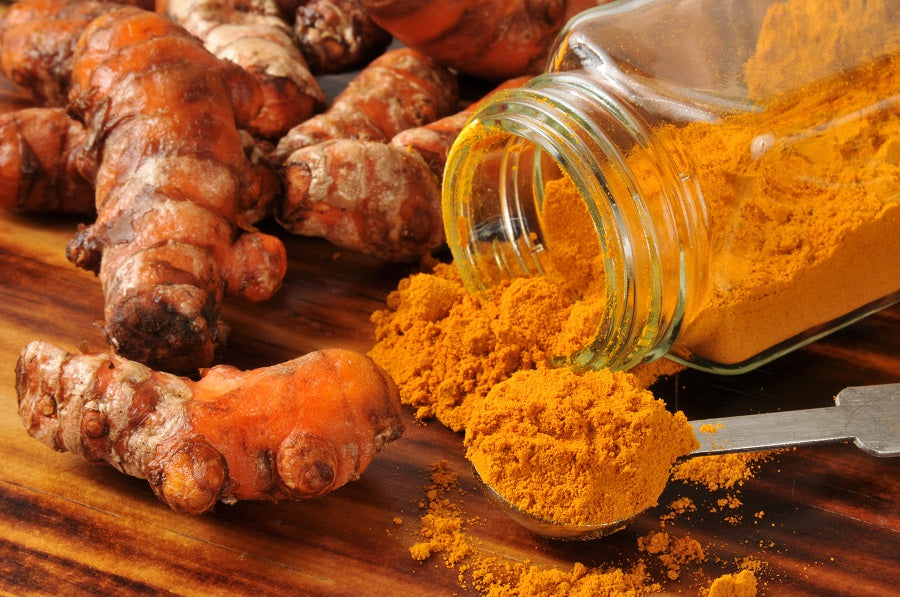
Turmeric an Antioxidant and Anti-inflammatory Superhero
If you’re like me, you have a cabinet in your kitchen stocked with colorful herbs and spices. But, let me ask you...do you use them often? If so, great! If not, I strongly encourage you to reconsider. Because herbs and spices are fragrant and flavorful. They satisfy your senses as well as your appetite.
They’re also jammed packed with powerful phytonutrients that reduce inflammation, fight free radical damage, improve digestion, balance blood sugar, and the list goes on and on. And while I recommend using a wide variety of herbs and spices to maximize your benefits, there’s one that stands out among the rest. And that’s turmeric.
What is turmeric?
Turmeric is a rhizome (a stem that grows horizontally underground) that is closely related to ginger. It even looks a little like ginger, except it’s a bit smaller and has an orange hue as opposed to yellow. Most likely you can find fresh turmeric in the same vicinity as ginger in the produce section. Or, you can find it dried and ground in the spice aisle.
Turmeric has long been used as a culinary spice around the world. Native to Southern Asia, it’s commonly found in Asian, Indian, and Pakistani cuisines. It offers a distinct aroma and flavor as well as a beautiful golden color to the dishes it’s added to. But the allure doesn’t stop there. Turmeric has been used by ancient Chinese and Ayurvedic medicine for centuries.
What conditions can turmeric be used to treat?
- Congestion
- Liver disease
- Allergies
- Menstrual irregularities
- Anorexia
- Bacterial and viral infections
- Injuries
- Digestive discomfort
- Asthma
This history and recent science positions turmeric as one of the most potent herbs on the planet when it comes to our health and well-being.
Turmeric as an antioxidant and anti-inflammatory superhero
Curcumin is the key active compound within turmeric as well as the most widely studied. It’s what gives turmeric its flavor and color as well as its exceptional antioxidant and anti-inflammatory powers. Antioxidants are necessary to fight oxidative stress caused by free radicals. And in today’s modern world, we’re constantly being bombarded due to chronic stress and lack of sleep as well as all the chemicals in our food, personal care products, and environment.
Now, many plants we eat are packed with antioxidants. But, what makes turmeric so unique is that it can also boost your body’s own antioxidant mechanisms. Thus, when you eat turmeric, free radicals don’t stand a chance. You might also be surprised to learn that turmeric has been shown to be as effective at reducing inflammation as ibuprofen as well as the prescription drug Voltaren (a nonsteroidal anti-inflammatory). And the best part is turmeric isn’t known to cause any serious side effects (while most anti-inflammatory medications are).
This is all important because oxidative stress and inflammation are often at the root of most modern diseases. They also contribute heavily to the dreaded signs of aging, such as wrinkly skin and painful joints. Thus, it makes sense that turmeric has been positively associated with many conditions, including:
- Heart disease
- Arthritis
- Type 2 diabetes
- Alzheimer’s disease
- Cancer
- Irritable bowel syndrome
- Crohn's disease
- Ulcerative colitis
But wait, there’s more benefits of turmeric in your diet!
If you like grilling meats, you’ll love turmeric even more. Because it’s one of a handful of spices that prevents the formation of cancerous compounds (a.k.a. heterocyclic amines) that form when meat is charred. Thus, adding turmeric to your spice rubs or marinades is always a good idea. In addition, this study has shown that turmeric enhances the absorption of beta-carotene from the veggies it’s prepared with.
How to Get More Turmeric in Your Daily Diet
The evidence is solid. We can all benefit from turmeric on a daily basis. And there are many delicious ways to add it to your diet. Consider the following:
- Add a small knob of fresh turmeric to your smoothie or homemade veggie juice
- Make “golden milk” - a turmeric tea with coconut or almond milk and other warming spices (perfect for winter months)
- Add a teaspoon of ground turmeric to your other spice mixes, such as taco or fajita seasonings
- Sprinkle your veggies with a little turmeric or curry powder (especially beta-carotene rich veggies, such as carrots, sweet potato, winter squash, kale, and spinach)
- Add a curry dish to your weekly repertoire
And note that your body’s ability to absorb and utilize turmeric’s active compounds is vastly improved when it’s paired with black pepper and/or fat.

The Bottom Line of Turmeric
Turmeric is an amazing spice that not only offers a wonderful aroma and flavor, but it also fights (and wins) against pesky free radicals and inflammation without any side effects. Thus, it’s a no brainer in my book. So what are you waiting for? Add turmeric to the top of your grocery list today!
Keep thinking Big and living BOLD!








